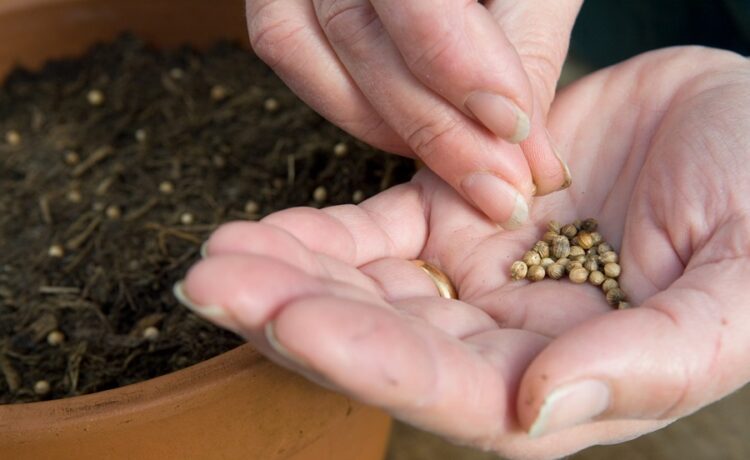Proper watering is essential for the successful growth of coriander seeds and plants. Here are some watering tips to help you grow healthy coriander in your garden:
- Consistent Moisture:
- Keep the soil consistently moist, especially during the germination and early growth stages. Avoid letting the soil dry out completely, as this can hinder seed germination and stunt seedling growth.
- Watering Frequency:
- Water coriander seeds lightly but frequently to keep the top layer of soil moist until the seeds germinate. After germination, water more deeply but less often to encourage strong root development. Aim for about 1 inch of water per week, depending on rainfall and soil type.
- Deep Watering:
- Once the plants are established, water deeply to encourage the development of a deep root system. Deep watering helps plants access moisture during dry periods and reduces the frequency of watering.
- Watering Method:
- Use a gentle watering method to avoid washing away seeds or damaging young seedlings. A fine mist or gentle setting on your watering can or hose works well. Drip irrigation systems or soaker hoses are ideal for providing consistent moisture without disturbing the soil.
- Time of Day:
- Water early in the morning to allow the plants to absorb moisture before the heat of the day. Morning watering also helps prevent fungal diseases by allowing the foliage to dry out during the day.
- Mulching:
- Apply a layer of organic mulch around the plants to retain soil moisture and reduce evaporation. Mulch also helps regulate soil temperature and suppress weeds, creating a more stable environment for coriander.
- Avoid Overwatering:
- While it’s important to keep the soil moist, avoid overwatering, which can lead to waterlogged soil and root rot. Ensure your soil has good drainage and allow the top inch of soil to dry out slightly between waterings.
- Rainfall Consideration:
- Adjust your watering schedule based on rainfall. If your area receives adequate rain, you may need to water less frequently. Use a rain gauge to monitor rainfall and adjust watering accordingly.
- Container Plants:
- If growing coriander in containers, check the soil moisture more frequently, as container soil tends to dry out faster than garden beds. Ensure containers have drainage holes to prevent waterlogging.
- Monitoring:
- Regularly check the soil moisture by inserting your finger about an inch into the soil. If it feels dry, it’s time to water. Monitoring helps you maintain the right moisture levels without over- or under-watering.
By following these watering tips, you can provide the optimal moisture conditions for your coriander seeds and plants, ensuring healthy growth and a successful harvest. Check out these gardening books and magazine.
What Are Some Sunlight Tips for Coriander Seeds in Your Garden?
Ensuring your coriander seeds and plants get the right amount of sunlight is crucial for their growth and productivity. Here are some tips to help you manage sunlight for coriander in your garden:
- Full Sun to Partial Shade:
- Coriander thrives in full sun to partial shade. Aim to provide your plants with at least 4-6 hours of direct sunlight per day. In hotter climates, partial shade during the hottest part of the day can help prevent bolting.
- Morning Sunlight:
- Plant coriander in a location that receives morning sunlight. Morning sun is less intense and helps dry the dew off the leaves, reducing the risk of fungal diseases.
- Afternoon Shade in Hot Climates:
- In regions with hot summers, protect coriander from the intense afternoon sun. Plant them in an area that gets shade in the afternoon, or use shade cloth to reduce the heat stress on the plants.
- Avoid Shady Areas:
- While partial shade is acceptable, avoid planting coriander in areas that are too shady. Insufficient sunlight can lead to leggy plants with reduced leaf production and poor overall growth.
- Row Orientation:
- Plant coriander in rows oriented north to south. This ensures that the plants receive even sunlight throughout the day and helps with air circulation, reducing the risk of disease.
- Interplanting:
- Consider interplanting coriander with taller plants like tomatoes or sunflowers that can provide some shade during the hottest part of the day. This can create a microclimate that benefits coriander.
- Use Reflective Mulch:
- In cooler climates, using reflective mulch can help increase the amount of light and heat around the plants, promoting better growth. Reflective mulch can also help deter pests.
- Seasonal Adjustments:
- Adjust the location of your coriander planting based on the season. In early spring and fall, full sun locations are ideal. During the peak summer months, partial shade can help prolong the harvest by preventing premature bolting.
- Container Gardening:
- If growing coriander in containers, you have the flexibility to move the pots to optimize sunlight exposure. Place containers in a sunny spot but move them to a shaded area during extreme heat.
- Monitoring Sunlight:
- Observe the sunlight patterns in your garden throughout the day. Note areas that receive the optimal amount of sunlight and adjust your planting strategy accordingly.
By following these sunlight tips, you can create an optimal environment for your coriander seeds and plants, ensuring healthy growth and a productive harvest.
What Is a Main Health Benefit of Coriander Seeds in Recipes?
Blood Sugar Regulation
- Supports Glycemic Control: Coriander seeds have been shown to help regulate blood sugar levels. They can be beneficial for people with diabetes by improving insulin sensitivity and reducing blood sugar spikes.
- Detoxification: The seeds can assist in detoxifying the body by promoting the elimination of toxins through improved digestion and metabolism.






